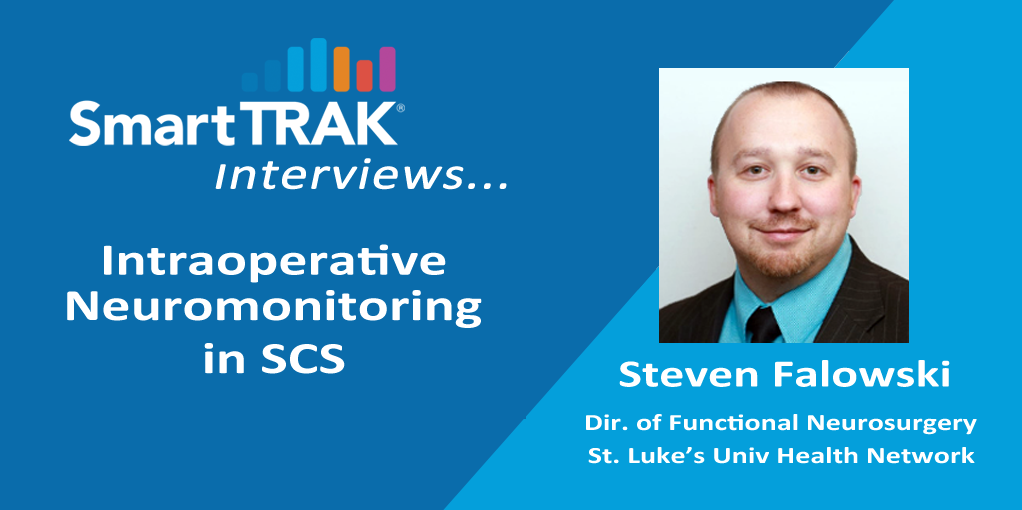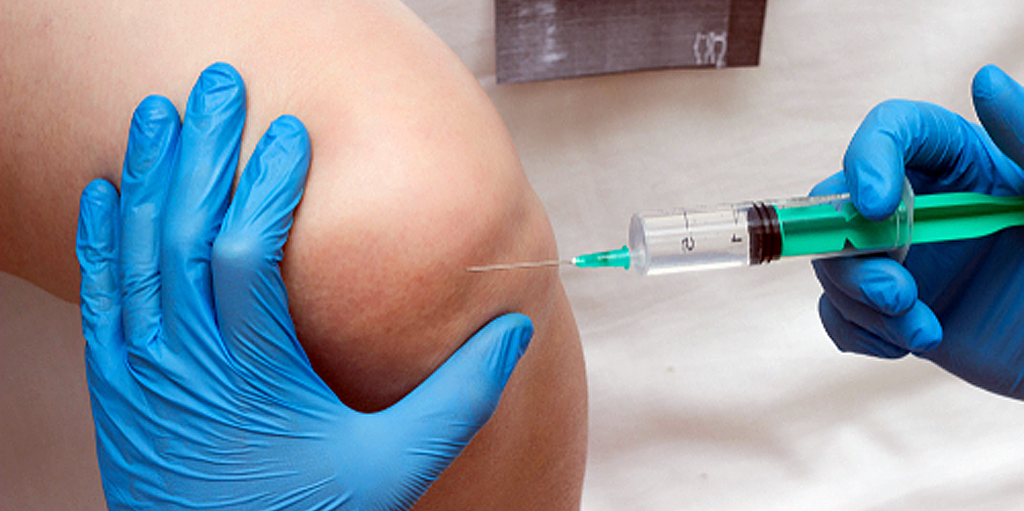 Intraoperative neuromonitoring could be a game changer in the field of SCS by elucidating the MOA for current and emerging SCS waveforms and stimulation patterns. But will it improve outcomes? To find out more, SmartTRAK interviewed Steven Falowski, MD at NANS 2019.
Intraoperative neuromonitoring could be a game changer in the field of SCS by elucidating the MOA for current and emerging SCS waveforms and stimulation patterns. But will it improve outcomes? To find out more, SmartTRAK interviewed Steven Falowski, MD at NANS 2019.
Historically, pain specialists have always placed spinal cord stimulators in awake patients for safety reasons and to confirm the therapy is adequately covering painful areas. However, Dr. Falowski says there’s been a paradigm shift where both pain physicians and surgeons alike are now using intraoperative neuromonitoring to place SCS systems for both percutaneous electrodes and paddle leads in asleep patients to more accurately localize the spinal cord midline and to improve intraoperative electrode placement and pain coverage...
Although much of the research in intraoperative neuromonintoring has been conducted in animals, advances in technology enabled Dr. Falowski to obtain recordings of the human spinal cord and to conduct research on elucidating the potential mechanisms of action of current and emerging SCS waveforms and stimulation paradigms. At NANS, Dr. Falowski presented the results from two human studies evaluating the use of intraoperative neuromonitoring during SCS. One study is a 15-patient observational case series (non-funded) in which electromyography (EMG) and somatosensory evoked potential (SSEP) collision testing was used to analyze traditional tonic stimulation, specific waveform and stimulation platforms, and amplitude differences among SCS devices from MDT, BSX, ABT, and NVRO. The second study is a sub-analysis of the Evoke US pivotal study, in which the Evoke SCS System was used in combination with standard intraoperative neuromonitoring systems during implantation of Evoke patients.
The real question is whether measuring the impact of different waveforms and elucidating these different mechanisms of action will equate into better outcomes. Dr. Falowski says early studies of evoked compound action potentials (ECAP)s suggest that the action potential can be potentially used as a marker of pain relief and three month outcome data from the Evoke study presented at NANS 2019 were promising. Looking to the future, Dr. Falowski believes these data will eventually provide diagnostic information that will allow physicians to better understand what patients are responding to what stimulation paradigm and why.
To find out more about Dr. Falowski’s research and what’s next for intraoperative neuromonitoring, click the following video to listen to SmartTRAK’s full interview with Dr. Falowski. A full transcript of the interview is also provided below.
Anne Staylor here with BiomedGPS. I'm at the NANS meeting in Las Vegas and today I get to talk with Dr. Steven Falowski, who is a functional neurosurgeon and the Secretary of the Board for NANS. Dr. Falowski, thanks for talking to me today.
Dr. Falowski: Thank you, Anne.
You gave a presentation here at NANS I found very intriguing on intraoperative neuromonitoring during spinal cord stimulation. You presented some of your research. I'm just going to start broadly, and say why intraoperative neuromonitoring during spinal cord stimulation?
Dr. Falowski: That's a great question, and we're actually starting to see a paradigm shift with the implantation of spinal cord simulators where historically they've always been placed awake. And the reason you keep a patient awake is so there's a safety measure to make sure you're not causing any type of nerve injury, but also to confirm that the electrode's in the right location when you turn it on, to cover their painful areas. There are a lot of aspects that can be better for the patient and for the physician if you can place the patient asleep. It's a more comfortable procedure. It's more streamlined.
But if you place them asleep, you lose that safety aspect and you lose the aspect of testing where the lead is so you have to use a form of what we call intraoperative neuromonitoring. Intraoperative neuromonitoring monitors the nerves for sensory and motor that go through the spinal cord so we can know if there's any safety measures that are compromised or for potentially injuring any nerves.
More importantly, for years now we've been developing protocols to confirm that the electrode's in the right location. So now using the intraoperative neuromonitoring we know that the electrode is getting proper coverage, or bilateral coverage, or where the painful areas are. So there's been several studies already on intraoperative neuromonitoring directly comparing it against the awake placement. It's actually shown superior results – about a fifth of the adverse events. It's quicker, more accurate. But we've actually extended on that research because that started with retrospective studies, as well as prospective studies.
We've now actually moved on, even farther past the research, because there's been a paradigm shift where more and more physicians, both pain physicians and surgeons alike, are using intraoperative neuromonitoring to place these systems for both percutaneous electrodes and paddles. But we've taken it now a step farther, where we started trying to elucidate mechanisms of action. How these different waveforms that we're using, and how the difference stimulation paradigms actually work. It's the first time we've ever gotten to see real human nerve recordings because this has all been done with animal modeling and computer modeling. So now the latest study that we've been publishing shows that the different waveforms do have different mechanisms of action. They can either cause inhibition, activation, they can penetrate deeper into the spinal cord, more likely to get back fibers. So it's a very interesting time, and there's a lot of data and science that can be gained from neuromonitoring.
Well, as you know, all the manufacturers are trying different waveforms or new stimulation patterns and that kind of thing. So have you looked at any specific type of waveforms and can say the effect of one versus the other?
Dr. Falowski: Yeah, absolutely. We've looked at, specifically, all the main waveforms that were on the market, such as Abbott's Burst DR waveform. Boston Scientific's Microburst, or what they call cycling as well as Nevro's high frequency stimulation. The one that showed the most dramatic results in the study was Abbott's Burst DR waveform. This is a five pulse sequence. So you would imagine that those five pulses should turn into five responses on the nerves in our neuromonitoring, but it actually turns into one big, very large response that penetrates very deep into the spinal cord. This is something we're not very used to with traditional tonic parameters that we've had, where it's a very one-to-one response. If you give a signal, you get a one time response.
This is actually a cumulative response that's very highly energy efficient. So we can test the amount of energy it takes to do it as well as opposed to the Boston Microburst or cycling, which is actually turning tonic stimulation, or traditional parameters, on and off for four times. And what that does, actually, it creates an energy equal, equivalent of tonic stimulation. So I think the main point to gain from these is elucidating these mechanisms of action don't necessarily say one works better than another, but it shows you how they're working differently and why one may be more likely to get the deeper back fibers in the spinal cord compared to another.
Is the measurement that you have of the spinal cord, and the effect of these different things, does that translate into improved outcomes? I mean, some people are looking at ECAPs and they're very good results but do ECAPs measure…is that the same as pain? How do you know what you're looking at is reflective of what will end up for a patient?
Dr. Falowski: That's a great question. One of the things we were able to show with just the use of intraoperative neuromonitoring is that it led to a more objective and accurate lead placement which potentially in the future leads to better outcomes. But the real question is whether these different waveforms, and elucidating these mechanisms of action equate into better outcomes and that's where something like ECAPs comes into play. These ideas of close-looped systems where we're listening to the spinal cord and recording those signals that come off it. We do know from some of the early studies that the use of ECAPs, you can use that action potential as potentially a marker of pain relief. And as long as you can always generate that same signal, or that same action potential, you should be able to maintain the pain relief.
So I think we're still in the early stages of where we're going with this, but I think that ultimately this is all going to lead to very objective lead placements and when we're using these objective measures we'll be able to determine who's actually going to respond. And more importantly, who's going to respond to what type of stimulation paradigm and I think we're getting very close.
Well, I think that's been one of the challenges with all the non-responders. People who lose efficacy. Do you think then, this will help identify, improve patient selection?
Dr. Falowski: I absolutely do. I think this is going to improve our patient selection. It's going to improve how well we place these electrodes. But more importantly, when we gain that idea of the action potential, or the pain relief, we're going to be able to maintain it, and maybe start addressing this idea of tolerance or loss of pain control.
Can it be used to evaluate any kind of neurostimulation? Right now you're just looking at spinal cord but could it, theoretically, be used to look at deep brain stimulation? Sacral nerve stimulation?
Dr. Falowski: Yes, absolutely. Even with spinal cord stimulation, we can measure brain waves in the operating room and where those waves are affected, whether it's in the, what we consider the sensory cortex, or what we consider the frontal lobes or the medial pathways of the brain that are the affective components of pain. What you think of your pain. We can measure that right now just for spinal cord stimulation. But also, there's now closed-loop technology that's been generated for deep brain stimulators as well. So now we're stimulating the brain and listening to the recordings in the brain. It's what they call LFPs.
Could you just tell us a little bit of some of the research you presented here at NANS on intraoperative neuromonitoring?
Dr. Falowski: Absolutely. It's been a progression with the research that I've presented over the years. One was proving that intraoperative neuromonitoring was a viable method. Then we moved on to recording from the waveforms and the different stimulation paradigms to elucidate mechanisms of action and how we can get true recordings off human nerves, which has never been done before since it's historically always been animal models and computer modeling. But now, my latest research that I got to present this year at NANS was looking at an objective way of placing the electrode without utilizing the neuromonitoring technician, or the neuromonitoring devices that we put like the needles prior to the surgery.
What we can do is we can stimulate off the stimulator, or the electrode and record at the same time. And we can now use that as an objective measure of placing the electrode. So what we do is we stimulate from the electrode off of the spinal cord, listen to the recordings to generate those action potentials , but then we are also looking for other responses that come. One of those responses is what they call a late response, which is where we think it's getting out to the lateral or the far portions of the spinal cord, which is where we don't want to be with stimulators.
What we've devised in our multi-center study is ways to look at those, and the ratios between that too. Now we have an objective way of saying that by comparing those ratios, where the electrode is on the spinal cord. If it's too far to the left, too far to the right. If it's not on the mid-line. So what this does is now this objectifies completely, placing the electrode. So it takes the subjectiveness of asking the patient where do you feel it? Is it where it's supposed to be? You know, it's very hard for a patient to say I feel it 60% on the left, and 40% on the right.
But by doing this now, and stimulating a recording through the same electrode, we can determine that. And we can determine whether we're exactly on the mid-line, or too far left, or too far right. But I think the ultimate goal where this research is going to go is eventually it's going to eliminate the need for everything that comes with neuromonitoring. The technicians, and the tools, and the pieces that we need in the operating room and not to mention just objectifying pain management.
This sounds exciting. So the technology itself, what companies have this technology?
Dr. Falowski: The company that's pioneering closed-loop technology is a company called Saluda. The reason that we were able to do these studies with the neuromonitoring technique is because we were a part of their multi-center randomized control trial with their investigational device to try to gain an FDA approval in the United States. So while we were doing the normal study for these patients, we also did these additional study parameters for intraoperative neuromonitoring.
Very cool. So then you weren't just looking at ECAPs?
Dr. Falowski: Correct. We were looking at multiple pieces of it. ECAPs, what they call late responses, and looking at the different stimulation paradigms with that.
I know that there's a good portion of patients, I don't remember the percentages, that are non-responders. You're a neurosurgeon, so you know this way better than I do, but isn't there sometimes where a patient needs surgery, but it isn't always 100% clear it's because they have a slipped disk, or if they should have spinal cord stimulation? Will that help determine that? Is this something that neuromonitoring can differentiate?
Dr. Falowski: Yes. I think for the future it's going to be. I think it's going to be a very objective way of placing these and determining those responders. We always say there's an inherent failure in everything. Nothing is 100% success. The question is, is why do some people not respond to spinal cord stimulation? Why do some people, after a time of responding, begin not to respond? And I think we're starting to elucidate that with these nerve recordings, human nerve recordings with intraoperative neuromonitoring. Because we're starting to see different people respond different ways to stimulation. I think that's why we have discrepancies between these different waveforms and stimulation parameters, and we're in the infancy of trying to figure out who can respond to which one. But I think this is the first step in truly objectifying who responds and why they respond, and why they'll respond to one stimulation over another.
Is this like kind of a geek registry, where you're keeping all of this data? And you'll be able to identify and diagnose people based on all the data you're collecting? Is that kind of something that's possible from what you're doing?
Dr. Falowski: Yes, absolutely. I think eventually it's going to be a sample size issue. So as soon as we can get enough patients, we'll be able to really go into the data and dive into the data and figure out who are those people who are responding and why. So that's why it's an exciting time. We're looking forward to closed-loop technology becoming commercialized and FDA approved because then we'll have access to give it to more patients outside of the investigational study, which will then open up the doors tremendously for us on looking at all these parameters.
So, even though it started with ECAPs, the very measurement in using that device could potentially help justify some of these other waveforms? I mean it isn't all just one waveform, right? I mean everybody is looking for the best waveform or stim pattern. But what I want to try and understand there's not just one way to solve this problem, correct?
Dr. Falowski: Correct. I mean everyone's looking for the next best waveform, or the next best way to stimulate the spinal cord. But what I will say is we've always done it in animals. We've done it in computer modeling. In humans, the only thing we could ever truly test was the clinical outcomes. Do they have pain relief? Are they doing well? But there was no way to truly know what it was doing to the nerves. That's what we call fixed output. We were just stimulating the spinal cord, but not listening to what's going on. The closed-loop technology allows us to listen to that. Intraoperative neuromonitoring not only allows us to listen to it, but also actually have recordings from the human nerves to determine what it's actually doing.
In the same Friday panel that you were on, Dr. Eldabe talked about trialing and whether we need trialing. Is this something in which patients that have this, do you think it may eliminate trials?
Dr. Falowski: I think in the future trials will be eliminated. I think that our— what we call trial to permanent ratio – is becoming so high. The success rates with these therapies, the different waveforms and stimulation paradigms that become so great, it's very unlikely that patients fail, especially initially. So it's becoming a point where trials are not really predicting any difference in our success rates, because our success rates are becoming so high. I think what's going to be interesting for the future is we'll probably be going directly to permanent implants without trials. And I think in probably the very near future, when we have these objective measures, too, when we go directly to permanent implants, we can be able to test right there, while we're placing the electrodes in, what type of parameters they're going to respond best to, and then that's what they're going to get after they have a permanent implant.
So in terms of justifying the whole idea of eliminating trials and use of intraoperative neuromonitoring. I'm assuming patients have to be under anesthesia for that placement. Will that be offset by the fewer explants? Because you're able to target the pain better? I'm just wondering about, you know, it's actually a radical departure from current practice, right? Eliminating trials and just putting someone to sleep to have this done. So is that justified do you think? Do you think it will be justifiable to payers?
Dr. Falowski: Trials historically have always been done awake. It's very rare that trials are done asleep. But there's a good percentage, as much as even 50% of the implants that go in for permanent implants, are done under anesthesia. This has been a growing trend for years. One of the first ever papers that came out on intraoperative neuromonitoring was in 2011 and that was a retrospective review. Although at the present time where we have the multi-center prospective study that also demonstrated the superiority, through that time period it has grown tremendously. We have done surveys through NANS. The companies have also followed what the physicians are doing, and there's been a really growing trend towards placing permanent implants asleep – both for the surgeons, but also for the pain physicians.
So how far away would you say intraoperative neuromonitoring is from prime time?
Dr. Falowski: I would say we're very close to it now. It's growing rapidly and I think the data is starting to show that it's faster, it's safer, it's more accurate and these are all the myths that are there with intraoperative neuromonitoring prior to that. It was going to take too much time. That it was too expensive. That there's no data that showed that it worked. And we've basically dispelled all those myths. And I think for the future, and especially what I think insurance payers are going to look for, is objective measures. In the future, I don't think insurance payers are going to like the subjective measure of a VAS pain score. Or just aimlessly placing an electrode on where you think mid-line is on an X-Ray and then hoping for the best. I think what they're really going to look for in the future is not only functional outcomes, but objectifying what we're doing. We are objectively showing that the electrode's in the right location. The nerves are responding the way they're supposed to respond. And the only way to do that is with either something like intraoperative neuromonitoring or with a closed-loop system where you can record through the electrode.
What's next for intraoperative neuromonitoring?
Dr. Falowski: That's a great question because we're looking at a lot of different paradigms now. Everything from what happens when you change pulse widths and frequencies in it, but also mapping out the different nerve fibers. One of the next steps we're doing is mapping out what we call the dorsal root ganglions, because there is a stimulator that specifically targets the dorsal root ganglion, but no one knows truly, for each level, where that DRG is. So with intraoperative neuromonitoring, we're now starting to map out where they are in each frame to determine whether it's farther out lateral, or more medial. So that's some of the next steps. And I think the true future of intraoperative neuromonitoring and what I'm working a lot on my research is getting to a point where you can eliminate all the equipment and the technicians that are needed for intraoperative neuromonitoring and getting to a point where you can do it all just through the system that you're implanting.
Thank you so much. This was very interesting. I appreciate your time.
Dr. Falowski: Thank you, Anne.
_________________________________________________
To download a copy of the the Intraoperative Neuromonitoring in SCS: An Interview with Steven Falowski, MD, please click the button below.







